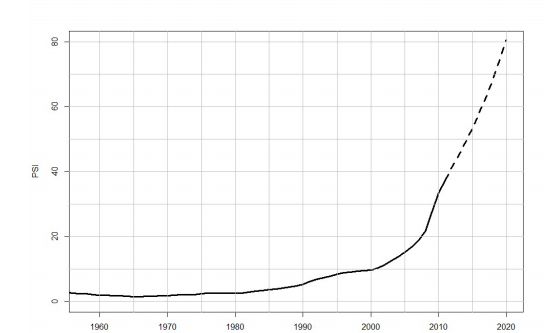
Date: May 6, 2019
Author: Paul Cockshott
I have produced a couple of videos recently on the danger posed by global warming. This is something that I have been concerned with since about 1977 when I wrote a report for the shop stewards committee at GEC Trafford Park, called Workers’ Power. It was for the shop stewards in the power plant manufacturing industry that was going through a crisis in the late 70s. In the report, we urged diversification into a number of non-fossil fuel types of power generation.

Proposed Severn Barrage
We argued for the Severn Barrage tidal scheme, wind turbines, geothermal power using the Dartmoor and Hebridean basalt formations and for the adoption of the Dragon High-Temperature Gas-cooled Reactor. We argued strongly against any type of water cooled reactors because of the inherent explosion risks that are associated with water cooling.

At that point it was becoming unfashionable to advocate nuclear power, but I was convinced even then that the potential loss of life due to droughts in Africa if we proceeded with fossil fuel far outweighed the danger from nuclear plants.
With the knowledge, we now have of the catastrophic impact that global warming can have on food production, I am even more convinced that my original judgement was right. We were right on the danger of fossil fuel, and we were right on the importance of not using water cooled reactors. The accidents at Chernobyl and at Fukushima were both from complications associated with water cooling.
At the time we were writing, the electricity production industry in the UK was a state owned monopoly. A change in fuel mix was thus just a matter of public policy. The state could decide to build no more fossil fuel plants and only commission wind, hydro and nuclear ones. The decision could be made at a political level without any decisions being taken about pricing.
A consequence of privatisation of electricity in the 1980s was that the government could no longer take such policy decisions ‘in kind’. It had to attempt to influence the now private industry through a series of subsidies or taxes. The consequence was that three important things happened.
- There was a dash for gas. Lots of gas turbine power stations were built. As compared to coal, these release somewhat less CO2 but they still release it.
- There were no new nuclear stations built for a couple of decades, during which the capacity to indigenously build gas cooled stations was lost. When stations started to be built again they were water cooled ones using French and Chinese designs. These countries which had retained state-owned electricity still had the capacity to build nuclear – but it was to a relatively less safe class of design.
- By dint of state subsidies a large number of wind powered turbines have been thrown up by private firms.
The combined effect is that now, this week, we have had 125 consecutive hours of electricity production without using coal. But had a consistent policy of building new gas-cooled atomic plants been pursued over the last 30 years we would have reached zero C02 emissions some years ago.
As it is, the zero emissions target is still decades off – awaiting sufficient new PWRs being built to replace the current gas turbine base load.
I give this history to illustrate why I favour in natura planning rather than the use of tax and price incentives. The latter approach is inherently tied to the neo-liberal economic model in which all concrete investment decisions are taken by profit maximising firms. The state is only allowed to intervene by promising these firms extra profits if they act in a particular way.
One tool advocated by green neoliberals is carbon taxation. Push up the cost of fuels containing carbon, they say, and then private firms will shift to carbon neutral technologies. There are several real flaws with this approach.
What level of tax?
For a start, the state does not know what the optimal level of carbon taxes would be in order to get the firms to act.
If the tax level is set too low, they may somewhat reduce carbon use, but not completely eliminate it. If it is set too high, the knock on cost to consumers will be prohibitive. But since the power stations are privately owned, and since the state does not know the true costings of even the current stations, far less the ones that have yet to be built, setting the right tax level is almost impossible.
If the state still owned the power industry, it would have an accurate picture of costs, but in those circumstances it would have no need for indirect tools like carbon taxes. The very premise – privatisation – that leads to the demand for carbon taxes, eliminates the possibility of setting these taxes rationally.
Redistributive effects
The socialist movement has traditionally opposed indirect taxation on the grounds that such taxes are regressive – they fall disproportionately on those with low incomes. Instead, socialists have favoured progressive rates of income tax.
The neoliberal right has wanted either flat taxes like Thatcher’s Poll Tax or indirect taxes like VAT. Since the Tories introduced VAT it has gradually provided an increasing share of total state revenue allowing income tax to be reduced. The net effect is regressive.
A carbon tax would hit those on low income having to heat their houses in winter more than anyone else. Wealthy people have the resources to invest in more insulation or solar panels on their houses. But in Scotland, about 25% of people are in fuel poverty, where they would have to spend at least 10% of their income to keep one room in their house at 21C. 7% of people have to spend 20% of their income to achieve this minimal warmth in one room. A high carbon tax immediately hits these people and would force another substantial portion of households into fuel poverty.
What alternative?
What should we advocate instead of carbon taxes?
We have to target the three big producers of CO2 : electric power, space heating and transport.
- Public ownership of energy production with targets set in kind by the state to eliminate fossil fuel use for electricity.
- Provision of district heating using waste heat from nuclear plants to replace gas heating of houses.
- Public ownership of all rented property with the government paying to convert all such houses to either electric heating or district heating.
- Phasing out of the national methane gas grid, with switches to electrolytic hydrogen for the changeover period.
- In-kind targets for transport – the other big use of fossil fuel.
- Immediate stop to the production of fossil fuel cars and busses.
- Switch car production to electric ones.
- Build electric tram networks in all large cities.
- Nationalised railway company to re-open old freight routes and build additional freight lines and terminuses.
- Stop production of fossil fuel trucks in 15 years time after the emergency expansion of the rail network has been completed.
- To deal with consumption by the existing stock of petrol and diesel vehicles and aircraft, impose fuel rationing.
Why Rationing?
If you have to restrict consumption, rationing is the fairest way to do it. Each citizen would get the same fuel ration. Rich people would only be able to continue to use their SUVs, and firms would only be able to operate diesel trucks, if they bought ration tokens off other people. The net effect, unlike carbon taxes, would be to redistribute income downwards.
But rationing is a stopgap until in natura planning has transformed the energy base of the economy.

